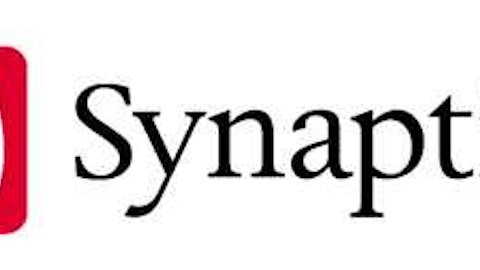Pangaea Logistics Solutions, Ltd. (NASDAQ:PANL) Q4 2023 Earnings Call Transcript March 14, 2024
Pangaea Logistics Solutions, Ltd. isn’t one of the 30 most popular stocks among hedge funds at the end of the third quarter (see the details here).
Operator: Good morning. My name is Todd and I will be your conference operator today. At this time, I would like to welcome everyone to the Pangaea Logistics Solutions Fourth Quarter and Full Year 2023 Earnings Teleconference. Today’s call is being recorded and will be available for replay beginning at 11 a.m. Eastern time. The recording can be accessed by dialing 800-839-5630 for domestic users or 402-220-2557 for international. All lines are currently muted and after the prepared remarks there will be a live question and answer session. [Operator Instructions] It is now my pleasure to turn the floor over to Stefan Neely with Vallum Advisors. Please go ahead.
Stefan Neely: Thank you, operator. And welcome to the Pangaea Logistics Solutions fourth quarter and full year 2023 results conference call. Leading the call with me today is CEO, Mark Filanowski; Chief Financial Officer, Gianni Del Signore; and COO, Mads Petersen. Today’s discussion contains forward-looking statements about future business and financial expectations. Actual results may differ significantly from those projected in today’s forward-looking statements due to various risks and uncertainties, including the risks described in our periodic reports filed with the SEC. Except as required by law, we undertake no obligation to update our forward-looking statements. At the conclusion of our prepared remarks, we will open the line for questions. With that, I would like to turn the call over to Mark.
Mark Filanowski: Thank you, Stefan, and welcome to those joining us on the call today. After the market closed yesterday, we issued a release detailing our fourth quarter and full year 2023 results. Our results were a good finish to the year as we continued to achieve a consistent TCE rate premium above our benchmark indices. While the fourth quarter is generally a slower period for Pangaea as we exit the peak of our Arctic trade season, ongoing geopolitical trade disruptions have led to increased demand within our traditional trade routes, contributing to increased shipping days in the period, together with a corresponding increase in freight rates. We reported adjusted net income of $7.4 million for the fourth quarter and $31.4 million for the year.
For the fourth quarter in 2023, our adjusted EBITDA of $19.7 million, though strong, declined on a year-to-year basis, even as our TCE rate exceeded our benchmark BSI Index by 27%. Market rate volatility can be impactful over quarterly periods, but our business model smooths the effects over longer periods. Our markets in the current quarter are showing surprising strength on a seasonal basis as global trade disruptions have led to persistent market inefficiencies, a dynamic supportive of a structurally higher freight rate environment. With supply growth limited by worldwide shipbuilding capacity to produce new ships in our segments, we think there is a long runway for continued strong performance. Beyond the favorable dynamics being created by geopolitical disruption, we continue to see strong demand growth in the core trades that we serve, specifically construction aggregates, cement, and iron ore and iron products.
Through today, we’ve booked over 3,500 shipping days at an average TCE rate of $17,430 per day versus a market rate of approximately $13,000 per day in the first quarter 2024. Given these favorable underlying demand conditions and our expanding cargo book, we intend to prioritize capital investment in fleet expansion and renewal while continuing to scale our onshore logistics capabilities. In addition to these organic and inorganic investments, we’ll seek to further fortify our balance sheet, all while continuing to support a consistent return of capital program as demonstrated by our consistent quarterly cash dividend. At a strategic level, we remain focused on providing a growing base of integrated shipping and logistics solutions that address the unique demands of our customers.
To that end, following the acquisition of three marine port terminal operations in Florida and Maryland in mid-2023, we’ve been actively working to expand our onshore relationships with new and existing customers. During 2024, we will expand our footprint across the US Gulf Coast and in Florida through strategic joint operations, partnerships, and site leases. We believe this approach is a lower-cost, less capital-intensive method of entering a market, albeit one that allows us to build stronger relationships with current and potential customers and is centered on building around our ocean transport offerings. This accelerating dry bulk demand growth, limited volume of new-build dry bulk vessels scheduled to enter service over the coming years, and a focus on expansion of our fleet and port terminal operations sets up for a favorable strategic success in 2024 and beyond.

With that, I’ll turn it over to Gianni for a deeper discussion of our fourth quarter financial results.
Gianni Del Signore: Thank you, Mark, and welcome to all of those joining us today. Our fourth quarter financial results continue to emphasize the flexibility of our business model. As we were able to deliver premium returns amid market volatility, strong year-over-year growth in shipping days, all while reducing our vessel operating expenses per day. Fourth quarter TCE rates were approximately $17,684 per day, a premium of 27% over the average published market rates for Supermax and Panamax vessels in the period, which is supported by ice class performance early in the quarter, as well as our long-term COAs and forward bookings, which lock in rates for future cargo performance. Our adjusted EBITDA declined year-over-year to $19.7 million.
Our adjusted EBITDA margin also declined year-over-year to 14.9%, given volatility in rates which negatively impacted our charter and expenses. We also recognized an unusually high canal transit fee during the quarter resulting from environmental disruptions at the Panama Canal. This fee resulted in a $1 million negative impact to our adjusted EBITDA during the fourth quarter and a reduction in our overall TCE earned. During the fourth quarter, we saw year-over-year increase in chartered-in days, which increased 33% due to increased demand from our customers and our ability to supplement our fleet with chartered-in vessels. However, in accordance with our short-term chartered-in strategy, we recognized higher spot chartered-in rates in comparison to our overall TCE, resulting in margin compression, which may happen during times of rising rate environment.
Through today, we’ve booked approximately 1,400 chartered-in days at an average cost of $17,100 per day in the first quarter of 2024. Furthermore, this dynamic was offset by lower vessel operating expenses net of technical management fee which decreased by 4% year-over-year from an average of $6,200 per day last year to $5,900 per day in the fourth quarter of 2023. The decrease continues to highlight the success of our efforts to manage vessel operating expenses. As we have mentioned in the past, we utilize forward freight agreements and bunker swaps to selectively hedge our exposure to the market on our long-term cargo contracts and forward bookings. This approach helps us lock in future cash flows and minimize the impact of market volatility but can lead to fluctuations in our reported results on a period to period basis.
Given the market volatility during the fourth quarter, our reported net income reflects an unrealized loss of approximately $5.7 million relating to the mark to market adjustments of bunker swaps, forward freight agreements, and our interest rate cap. In total, our reported GAAP net income attributable to Pangaea for the fourth quarter was $1.1 million or $0.02 per diluted share compared to $15.5 million or $0.34 per diluted share in the fourth quarter of last year. When excluding the impact of the unrealized losses from derivative instruments that I mentioned, as well as other non-GAAP adjustments, our reported adjusted net income attributable to Pangaea during the quarter was $7.4 million, or $0.16 per diluted share, a decrease of $6.9 million, or $0.16 per diluted share versus the fourth quarter of last year.
Moving on to cash flows, total cash from operations decreased by $9 million year-over-year to $23.9 million due to decrease in TCE rates. At quarter-end, the company had $99 million in cash and total debt, including financial lease obligations of approximately $268 million. Of the $268 million in debt, approximately $20 million represents a balloon payment that is due in May of this year. This credit facility is currently locked at a fixed rate of 3.96% and we are currently evaluating numerous refinancing partners as well as the potential of paying off the debt in owning the underlying vessels outright. During quarter we continued to see relatively muted impact from higher interest rates due to our fixed rate and capital rate debt as well as benefits from interest yielding deposits which generated nearly $1 million in interest income.
At the end of the fourth quarter of 2023, the ratio of net debt to trailing 12-month adjusted EBITDA was 2.1 times. As Mark mentioned, our capital allocation focus in 2024 is investing in growth by expanding our onshore footprint in owned vessel capacity. Our current balance sheet and the strong cash flow profile of our business gives us the flexibility to be thoughtful about the most advantageous ways to finance our growth plans. Importantly, I would reiterate that we continue to prioritize a consistent return of capital strategy. We believe that our current dividend is one that we can sustain through the market cycle. With that, we will now open the line for questions.
See also 10 Best Mid-Cap Dividend Aristocrats To Buy and Top 20 Mineral Importing Countries in the World.
Q&A Session
Follow Pangaea Logistics Solutions Ltd. (NASDAQ:PANL)
Follow Pangaea Logistics Solutions Ltd. (NASDAQ:PANL)
Operator: [Operator Instructions] Our first question comes from Liam Burke with B. Riley. Please go ahead.
Liam Burke: Yes, good morning, Mark. Good morning, Gianni.
Mark Filanowski: Hi, Liam.
Liam Burke: Mark, can we discuss the charter hire, charter-in expenses that sort of squeezed your margin during this quarter? Flexing your fleet using leased vessels, chartered-in vessels as part of your overall strategy, was this a short-term anomaly in terms of the margin squeeze and does that make you think about your longer-term strategy about chartering vessels?
Mark Filanowski: No, the strategy is still solid, Liam. This isn’t unusual for us in times of where we book cargo forward today and we don’t perform until a month from now. Things can happen in the market that cause the chartered-in fleet to be a bit more costly as market rates rise. When they go the other way, it becomes cheaper for us to bring in ships. So we’re careful on the cargo we book and the timing we take to charter in ships. But when we have a big spike like we did in December, unexpected, it can temporarily cause a little disruption. We’re also — it depends a little bit on where, if you’re comparing to the charter-in cost to the market, it depends a little bit on where that increase in market rates occurred, if it occurred in the places where we are active, say the North Atlantic, that North Atlantic did spike a bit more than the rest of the world.
So if you’re comparing our charter-in cost to the worldwide rates, then we’re a little bit higher than if you compare to just the North Atlantic market.
Gianni Del Signore: Great. And, Liam, If I could just add, it’s Gianni, just to add, it’s not necessarily — when we look at it on a quarterly — a quarter by quarter basis, we’ll see these — potentially these reductions in margin or expansion in margin. And for example, Q1 of ‘22, we were in a similar situation. The chartered-in fleet did have a negative margin for the first quarter of ‘22. But — so we look at it quarter by quarter, and then these spikes in market rates can result in that margin squeeze. But for the full year, just to say it, for the full year of 2023, the margin on our chartered-in fleet was around $1,800 a day. So it was a positive, and it continues to be. So I don’t think there’s any — it is unfortunate for the quarter, but when we look at it on a long-term basis, it’s consistent with what we want to accomplish.
Mark Filanowski: Yeah, we do look at the pieces, what it costs us to charter in ships versus and what those charter-in ships produce against our charter — cargo book or spot cargoes. But the concept here is that we free up tonnage on our own ships that can then participate in a higher market. So although we do look at the pieces, we’re really trying to make the whole work better.
Liam Burke: Great. Thank you, Mark. On the first quarter partial fixtures, sequentially it’s almost flat, where typically you’d expect it to be down with first quarter being a seasonally slow quarter. Is that primarily the Panama Canal or there are other things in there that’s giving you a — really it looks like a seasonally strong, I mean, a strong, seasonally slow first quarter?
Mads Petersen: Yeah. Hi, Liam. It’s Mads here.
Liam Burke: Hi, Mads.
Mads Petersen: The Panama Canal of course has an effect, but I think the main driver is also the fact that we were able to put cargo in Q4 that we are now executing on in Q1 at what are historical pretty attractive levels. So of course, it’s a result of the general strengthening, but also the fact that we were able to secure some pretty decent paying forward cover.
Liam Burke: Great. Thank you, Mads. Thank you, Mark. Thank you, Gianni.
Mark Filanowski: Yep. Thanks, Liam.
Operator: Thank you. Our next question comes from Poe Fratt with Alliance Global Partners. Please go ahead.
Poe Fratt: Good morning, Mark. Good morning, Gianni. Good morning, Mads. Good to see you on Monday. Hey, can we just dig a little deeper in the charter hire expense? It was roughly $34 million for the quarter. Do you have — I’m calculating that your charter-in days were about 1700 — 1750. And so I’m calculating a chartered-in expense in the fourth quarter of just over $19,000. Is that — are those numbers close or can you give us an idea of those?
Gianni Del Signore: Yeah, I can give you the numbers, Poe.
Poe Fratt: That’d be great.
Gianni Del Signore: So yes, and actually in my prepared — in our remarks earlier in the call, I did also mention what the charter-in cost is for the first quarter, what we’ve sort of booked and encouraged so far. So you have that as well. But for the fourth quarter, the charter-in cost was $17,986 per day. The charter-in days were approximately 1,800 charter-in days.
Poe Fratt: Okay, great. And then looking at that forward chartered-in cost of 1,300 days at $17,100, how many — can you give me an appreciation for sort of how the whole quarter might look like? Will the chartered-in days be close to what they were in the fourth quarter? And the cost should be a little bit lower just because maybe you can avoid that spike that you saw in December?



